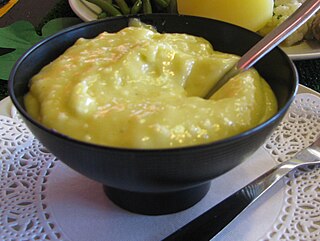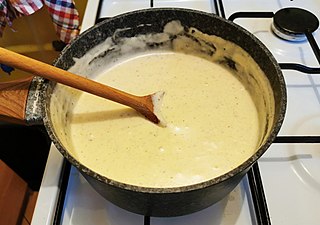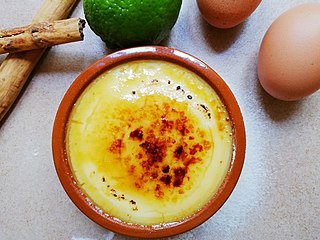Related Research Articles

Aioli, allioli, or aïoli is a cold sauce consisting of an emulsion of garlic and olive oil; it is found in the cuisines of the northwest Mediterranean.

Mayonnaise, colloquially referred to as "mayo", is a thick, cold, and creamy sauce commonly used on sandwiches, hamburgers, composed salads, and French fries. It also forms the base for various other sauces, such as tartar sauce, fry sauce, remoulade, salsa golf, ranch dressing, and rouille.

Catalan cuisine is the cuisine from Catalonia. It may also refer to the shared cuisine of Northern Catalonia and Andorra, the second of which has a similar cuisine to that of the neighbouring Alt Urgell and Cerdanya comarques and which is often referred to as "Catalan mountain cuisine". It is considered a part of western Mediterranean cuisine.

Lasagna, also known as lasagne, is a type of pasta, possibly one of the oldest types, made in very wide, flat sheets. In Italian cuisine it is made of stacked layers of pasta alternating with fillings such as ragù, béchamel sauce, vegetables, cheeses, and seasonings and spices. The dish may be topped with grated cheese, which melts during baking. Typically cooked pasta is assembled with the other ingredients and then baked in an oven. The resulting baked pasta is cut into single-serving square or rectangular portions.

Salsa criolla is a type of sauce or relish found in Latin American cuisine, composed of finely chopped sliced onions, vinegar, tomatoes, garlic, chili peppers, bell peppers, olive oil, salt, pepper and fresh herbs like parsley or cilantro. Salsa criolla is often associated with Peruvian cuisine, but also found in Cuban, Puerto Rican, Nicaraguan, Uruguayan, and Argentinian cuisine.

Salsa encompasses a variety of sauces used as condiments for tacos and other Mexican and Mexican-American foods, and as dips for tortilla chips. They may be raw or cooked, and are generally served at room temperature.

An empanada is a type of baked or fried turnover consisting of pastry and filling, common in Spain, other Southern European countries, North African countries, Latin American countries, and the Philippines. The name comes from the Spanish empanar, and translates as 'breaded', that is, wrapped or coated in bread. They are made by folding dough over a filling, which may consist of meat, cheese, tomato, corn, or other ingredients, and then cooking the resulting turnover, either by baking or frying.

Béchamel sauce is one of the mother sauces of French cuisine, made from a white roux and milk, seasoned with ground nutmeg.

Crema catalana 'Catalan cream' or crema cremada 'burnt cream' is a Catalan and Spanish dessert consisting of a custard topped with a layer of caramelized sugar. It is "virtually identical" to the French crème brûlée. Like all custards, it is made from milk, egg yolks, and sugar. Some modern recipes add cornflour. It is typically flavored with lemon zest, cinnamon, or vanilla, and a crisp caramel crust is made by caramelizing sugar placed on top of the custard.

Romesco is a tomato-based sauce that originated from Valls, province of Tarragona, in Catalonia, Spain. The fishermen in this area made this sauce to be eaten with fish. It is typically made from any mixture of roasted tomatoes and garlic, toasted almonds, pine nuts, and/or hazelnuts, olive or sunflower oil, and nyora peppers. Flour or ground stale bread may be used as a thickener or to provide texture.

Xató is a typical Catalan dish. It is a sauce made with almonds, hazelnuts, breadcrumbs, vinegar, garlic, olive oil, salt, and the nyora pepper. The sauce is often served with an endive salad prepared with anchovy, tuna and dried and salted cod (bacallà).

Hippocras sometimes spelled hipocras or hypocras, is a drink made from wine mixed with sugar and spices, usually including cinnamon, and possibly heated. After steeping the spices in the sweetened wine for a day, the spices are strained out through a conical cloth filter bag called a manicum hippocraticum or Hippocratic sleeve, from which the name of the drink is derived.

Picada is one of the characteristic sauces and culinary techniques essential to Catalan cuisine. The technique is typically found in Catalonia and Valencia and subsequently Catalan cuisine and Valencian cuisine. It is not an autonomous sauce like mayonnaise or romesco, but it is added as a seasoning during the cooking of a recipe.
Powder-douce is a spice mix used in Medieval and Renaissance cookery. Like modern spice mixes such as Italian seasoning or garam masala, there was not a set ingredient list, and it varied from cook to cook. The author of the 14th-century manuscript Le Ménagier de Paris suggested a mix of grains of paradise, ginger, cinnamon, nutmeg, sugar, and galangal.
Robert de Nola, also known by pseudonym Mestre Robert, was a Spanish chef who authored the first printed cookbook in Catalan language, Llibre del Coch. He served as cook to King of Naples Ferdinand I.

Hierbas de Mallorca or Herbs de Majorca is a Mallorcan herbal liqueur of medicinal origin. A form of the generic Hierbas, Hierbas de Mallorca has a protected designation of origin and can only be made in Mallorca.

Sharbat is a drink prepared from fruit or flower petals. It is a sweet cordial, and usually served chilled. It can be served in concentrated form and eaten with a spoon or diluted with water to create the drink.

Almadroc is a garlic-cheese sauce from medieval Catalan cuisine from the Llibre de Sent Soví. There is a similar recipe in the Llibre del Coch by Rupert de Nola for almadrote, a similar recipe for a sauce made with garlic, eggs, cheese and broth that was served with partridge. In modern usage it refers to an oil, garlic and cheese sauce served with eggplant casserole. Almadrote may have pre-Inquisition Sephardic origins and served with eggplant has become widespread in modern Turkish cuisine.

The Libre del Coch, or Libre de doctrina per a ben servir, de tallar y del art de coch cs de qualsevol manera, potatges y salses compost per lo diligent mestre Robert coch del Serenissimo senyor Don Ferrando Rey de Napols, is a Catalan recipe book written around 1490 by Master Robert de Nola. Its earliest preserved printed edition is from 1520, published in Catalan in Barcelona. It includes mainly recipes from the Catalan cuisine of the time, some of them inherited from the Libre de Sent Soví, and some from neighboring countries, such as the Occitan cuisine and the Italian cuisine, including traditions from different areas dominated by the Crown of Aragon, which at that time was spread to the northeastern Mediterranean, Southern Italy, Corsica and Sicily. Despite not including Castilian recipes, was also very successful in Castile, was translated into Spanish in 1525 and republished in this language several times. It is considered of great value for acquiring a good knowledge about the gastronomy of the Renaissance.
References
- ↑ Pedralbes. Universidad de Barcelona.
- ↑ "Pollastre o capó rostit amb salsa de pagó". Fundació Institut Català de la Cuina.
- ↑ Food in Motion The Migration of Foodstuffs and Cookery Techniques : Proceedings : Oxford Symposium. Oxford Symposium. 1983. ISBN 9780907325154.